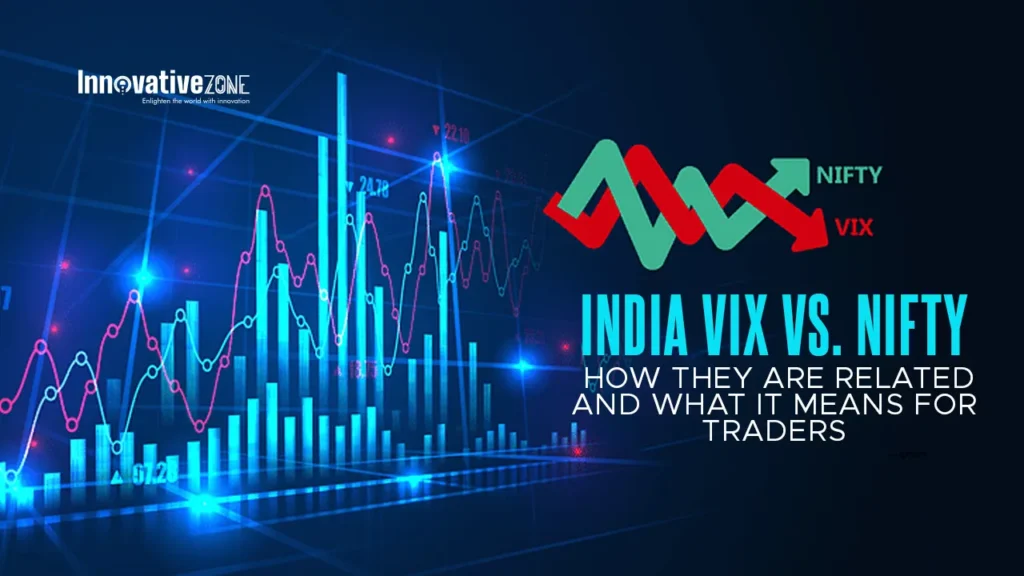Stock market volatility is a key concern for traders and investors alike. If you actively track sensex today or monitor Nifty 50 movements, you might have come across a crucial index—India VIX (Volatility Index). This index is often referred to as the “Fear Gauge” of the Indian stock market. But how does it relate to Nifty 50, and what does it mean for traders?
In this detailed article, we’ll explore the relationship between India VIX and NIFTY, how traders can use this information to make informed decisions, and why monitoring these indicators is crucial when trading stocks. Whether you are a seasoned trader or someone looking to open a demat account, understanding this relationship can significantly enhance your market strategy.
What is India VIX?
India VIX, or the Volatility Index, measures the market’s expectation of volatility in the near term. It is derived from the Nifty 50 options prices and represents the expected movement in the index over the next 30 days.
Key Features of India VIX:
- Calculated using Nifty 50 options (out-of-the-money options).
- Expressed as an annualized percentage (e.g., a VIX of 20 means an expected 20% annual volatility).
- Moves inversely to Nifty 50—rising when markets fall and falling when markets rise.
- A higher VIX indicates higher uncertainty and fear, while a lower VIX suggests market stability.
India VIX and Market Sentiment
India VIX is crucial for traders as it helps them gauge market sentiment. If you are involved in trading stocks or derivatives, keeping an eye on VIX can help you assess potential risks and opportunities.
What is Nifty 50?
The Nifty 50 is India’s benchmark index comprising the top 50 companies listed on the National Stock Exchange (NSE). It represents the overall health of the stock market and is a widely tracked index by traders and investors.
Key Features of Nifty 50:
- Represents large-cap companies across various sectors.
- Acts as a barometer for the Indian economy and stock market performance.
- Used for index-based trading, futures and options contracts.
- Directly linked to India’s equity market trends.
Since Nifty 50 is the underlying index for India VIX, any movement in the former directly impacts the latter. The question is—how exactly do these two indices interact with each other?
India VIX vs. Nifty 50: Understanding the Inverse Relationship
India VIX and nifty 50 share a negative correlation—meaning they generally move in opposite directions. When the market is bullish (Nifty 50 rising), India VIX falls because traders feel confident, and there is lower demand for protective options. Conversely, when the market is bearish (Nifty 50 falling), India VIX rises due to increased uncertainty and fear.
India VIX vs. Nifty 50: Historical Trends
| Year | India VIX Highs (Volatility Peaks) | Nifty 50 Lows (Bearish Movements) |
| 2008 (Financial Crisis) | 85+ | Nifty crashed 50% |
| 2020 (COVID-19 Crash) | 86+ | Nifty fell 35% in a month |
| 2022 (Russia-Ukraine War) | 35+ | Nifty corrected 15% |
| 2023 (Banking Crisis) | 20+ | Nifty saw moderate correction |
From the table above, it’s evident that whenever India VIX spikes, Nifty 50 faces selling pressure.
How Traders Can Use This Information
- High VIX (Above 20-25)
- Indicates market uncertainty and volatility.
- Traders should avoid aggressive long positions and focus on hedging.
- Best time for options traders (buying straddles/strangles).
- Low VIX (Below 15-18)
- Suggests a stable or bullish market.
- Ideal for long-term investors looking for buying opportunities.
- Traders can write options (sell puts/calls) to earn premiums.
By tracking India VIX and Nifty 50 movements, traders can time their market entries and exits more efficiently.
How India VIX Impacts Trading Strategies
1. Options Trading and India VIX
Options traders use India VIX to determine option premiums. When volatility is high, option prices rise, making it expensive for buyers but profitable for sellers.
| Market Condition | India VIX | Options Strategy |
| High Volatility (VIX > 25) | Expensive options | Buy straddles/strangles |
| Moderate Volatility (VIX 15-25) | Fairly priced options | Sell covered calls/puts |
| Low Volatility (VIX < 15) | Cheap options | Sell options for premium income |
Thus, a trader planning to trade Nifty 50 options should always factor in India VIX movements before placing trades.
2. Equity Trading and India VIX
For stock traders, India VIX acts as an early warning system. A sudden spike in VIX could mean an upcoming correction in the market.
- When India VIX is rising, traders should consider reducing leveraged positions.
- When India VIX is falling, it may signal a low-risk period for accumulating quality stocks.
Final Thoughts: How Traders Can Benefit from India VIX and Nifty 50 Analysis
Understanding the India VIX and Nifty 50 relationship is crucial for traders who wish to navigate market volatility effectively. Whether you trade in stocks, options, or futures, India VIX can serve as an important risk management tool.
Conclusion
- India VIX and Nifty 50 move inversely—high VIX means bearish markets, low VIX means bullish markets.
- Options traders should use VIX to determine option pricing strategies.
- Equity traders can use VIX to assess market risk and time their investments.
- If you actively track Sensex today, also keep an eye on India VIX for market sentiment analysis.
- If you’re new to the stock market, consider opening a demat account to start trading and applying these insights.
By keeping a close watch on India VIX and Nifty 50 trends, traders can gain an edge in the market and make informed decisions with confidence.


